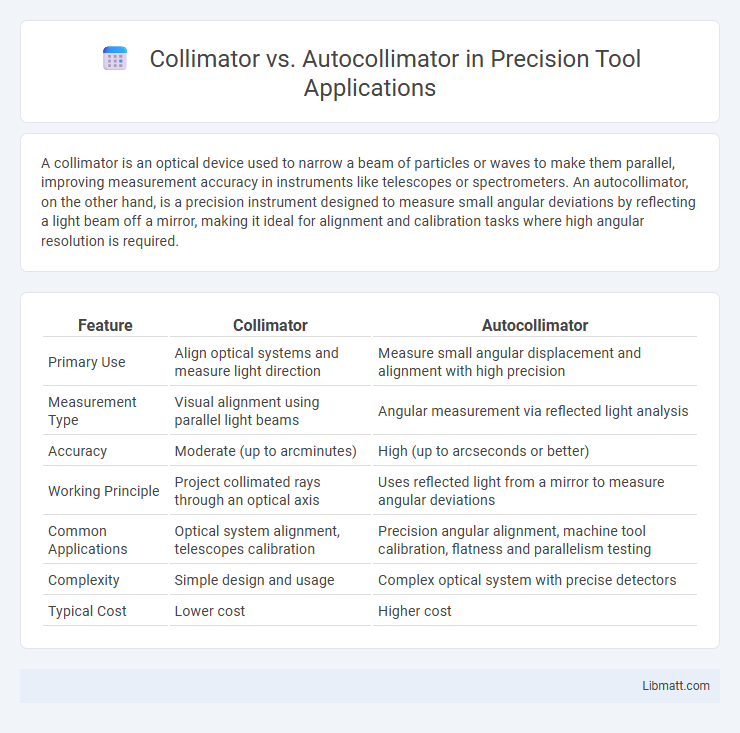A collimator is an optical device used to narrow a beam of particles or waves to make them parallel, improving measurement accuracy in instruments like telescopes or spectrometers. An autocollimator, on the other hand, is a precision instrument designed to measure small angular deviations by reflecting a light beam off a mirror, making it ideal for alignment and calibration tasks where high angular resolution is required.
Table of Comparison
| Feature | Collimator | Autocollimator |
|---|---|---|
| Primary Use | Align optical systems and measure light direction | Measure small angular displacement and alignment with high precision |
| Measurement Type | Visual alignment using parallel light beams | Angular measurement via reflected light analysis |
| Accuracy | Moderate (up to arcminutes) | High (up to arcseconds or better) |
| Working Principle | Project collimated rays through an optical axis | Uses reflected light from a mirror to measure angular deviations |
| Common Applications | Optical system alignment, telescopes calibration | Precision angular alignment, machine tool calibration, flatness and parallelism testing |
| Complexity | Simple design and usage | Complex optical system with precise detectors |
| Typical Cost | Lower cost | Higher cost |
Introduction to Collimator and Autocollimator
A collimator is an optical device that narrows a beam of particles or waves to make them parallel, commonly used in telescopes and medical imaging. An autocollimator is a precise optical instrument designed to measure small angular deviations by reflecting light off a surface and analyzing its return path. Both tools are essential in alignment, calibration, and precision measurement tasks across engineering and scientific applications.
Fundamental Principles of Operation
A collimator projects a parallel beam of light to align optical devices, using a light source and an optical system to create precise directional beams. An autocollimator combines the functions of a collimator and telescope, measuring angular displacement by reflecting a beam off a target mirror and detecting changes in the return image. Understanding these fundamental principles ensures accurate alignment and angle measurement in optical and mechanical systems critical for your precision work.
Key Differences Between Collimator and Autocollimator
A collimator aligns light beams to ensure parallelism and is primarily used for initial optical alignment and calibration, while an autocollimator offers precise angular measurement by detecting minute deviations in reflected light. Collimators generally produce a fixed, parallel beam for rough alignment tasks, whereas autocollimators measure angular displacement with high accuracy by analyzing the position of a reflected image on a reticle. The key difference lies in their application scope: collimators facilitate basic beam direction control, while autocollimators provide precise angular measurement and calibration in high-precision optical engineering.
Applications in Optical Metrology
Collimators are primarily used in optical metrology to produce parallel light beams for alignment and calibration of optical systems, ensuring precise measurements in instruments like telescopes and cameras. Autocollimators offer enhanced precision by detecting angular deviations through reflected light, making them ideal for alignment of optical components, calibration of angular encoders, and measurement of small angular displacements in high-accuracy applications. Your choice between a collimator and an autocollimator depends on the required measurement accuracy and the specific optical metrology task at hand.
Design and Construction Features
Collimators feature a simple design with a light source and a slit, primarily used to produce parallel rays for alignment purposes, while autocollimators incorporate a sophisticated optical system with a beam splitter and a mirror, enabling precise angle measurements by reflecting light back through the same path. Autocollimators often include high-precision optics and adjustable reticles to enhance accuracy, making them more complex and sensitive compared to the basic, robust construction of standard collimators. Understanding these design and construction differences helps you select the right device for precision alignment or angular measurement tasks.
Accuracy and Precision Comparison
The autocollimator offers significantly higher accuracy and precision compared to a standard collimator, typically achieving angular measurement resolutions down to 0.1 arc seconds, whereas collimators generally provide measurements within a few arc minutes. Autocollimators use optical feedback and electronic detectors to minimize human error and improve repeatability, making them ideal for fine alignment and calibration tasks. Collimators, while simpler and more affordable, are best suited for rough alignment due to their lower sensitivity and limited resolution.
Alignment and Calibration Processes
Collimators provide precise alignment by projecting a beam of light or radiation to establish straightness and direction, crucial for initial machine setup and optical system calibration. Autocollimators enhance calibration accuracy through reflective feedback, measuring angular deviations with high sensitivity, making them essential for fine-tuning and verifying alignment in optical instruments. Your choice depends on the required precision level, as autocollimators offer superior angular measurement capabilities compared to standard collimators.
Advantages and Limitations
A collimator offers simplicity and cost-effectiveness for aligning optical systems by producing parallel light beams, making it ideal for basic alignment tasks. In contrast, an autocollimator provides high precision and the ability to measure angular deviations with micron-level accuracy, which is crucial in applications demanding exact surface angle measurements or calibration. Your choice depends on whether you need straightforward alignment with low cost or highly accurate angular measurements for advanced optical setups.
Factors to Consider When Choosing
When choosing between a collimator and an autocollimator, consider the required measurement accuracy and the specific application environment. Collimators are ideal for simpler alignment tasks, offering ease of use and cost-effectiveness, while autocollimators provide high-precision angular measurements with advanced optical setups. Your decision should also factor in the measurement range, resolution, and calibration capabilities to ensure optimal performance for your instrument alignment or optical testing needs.
Conclusion and Future Trends
Collimators provide precise beam alignment in optical systems, while autocollimators offer enhanced angular measurement accuracy, making them essential in high-precision engineering and metrology. Emerging trends include integrating digital imaging technology and automated calibration, which bolster measurement efficiency and reduce human error. Your choice between these devices should consider the required precision level and future adaptability to advanced optical diagnostics.
Collimator vs autocollimator Infographic

 libmatt.com
libmatt.com